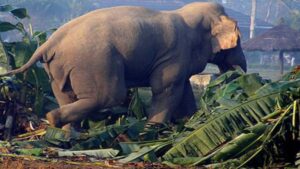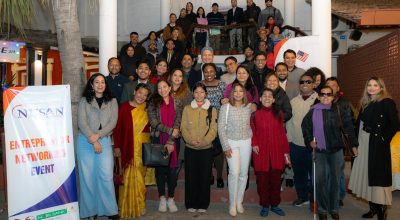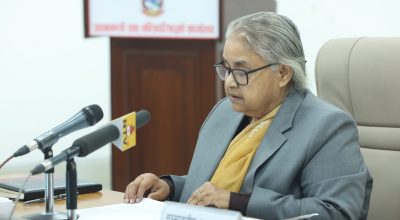
“Tell me what you eat and I’ll tell you what you are” this saying by Jean Anthelme Brillat-Savarin, a French lawyer and politician, reflects how food is important to humans. Savarin in his book ‘The Physiology of Taste, Or, Meditations on Transcendental Gastronomy’ points out that the food one eats has a bearing on one’s state of mind and health.
Besides defining our identity, food creates our mental, physical, social and economic existences. How we eat determines what we become. Food is a basic human need and right, and the Constitution of Nepal has guaranteed people’s right to food.
According to the 2022 Global Hunger Index (GHI), Nepal ranks 81st out of the 121 countries with a score of 19.1, which signifies Nepal has a moderate level of hunger. Nepal has continued to do improvements on the GHI scores in the past 22 years. Nepal scored 37 on the GHI Trend in 2000. The score dropped to 30 in 2007, 21.2 in 2014 and 19.1 in 2022.
The index less than 10 points reflect low hunger, and between 10 and 19.9 moderate hunger. Similarly, from 20 to 34.9 indicates serious hunger, and from 35 to 49.9 alarming. Above 50 reveals extremely alarming. So, as the GHI shows, Nepal is at the border between moderate and serious hunger.
On the score range, Nepal is behind Sri Lanka which is ranked 64th with 13.6 points, and ahead of India which dropped to 107th with 29.1 points. Similarly, Pakistan is ranked 99th with 26.1, Afghanistan 109th with 29.9, Bangladesh 84th with 19.6 points.
The GHI 2022 report jointly published by the Concern Worldwide and Welthungerhilfe was co-launched by the Minister for Foreign Affair Dr Bimala Rai Paudyal amid a function organised here by the NGO Federation of Nepal.
GHI scores are calculated based on a formula combining four indicators—undernourishment, child stunting, child wasting and child mortality—that together capture the multidimensional nature of hunger, said Dr Yamuna Ghale, food security expert.
Nepal has done significant progress in reducing child stunting and wasting rate over the past 16 years.
According to the Nepal Demographic and Health Survey (NDHS) 2022, 25 percent of children under age 5 are stunted, 8 percent wasted, and 19 percent underweight. One percent of children under age 5 are overweight.
The prevalence of child stunting has declined from 57 percent in 1996 to 25 percent in 2022. During this same period, the prevalence of child wasting has decreased from 15 percent to 8 percent, and the prevalence of overweight was steady at 1 percent.
Globally, one in five deaths among children under the age of five is attributed to severe wasting, making it one of the top threats to child survival, killing more than 1 million children every year, according to the UNICEF (United Nations International Children’s Emergency Fund) Child Alert.
Health experts have blamed malnutrition responsible for hunger, and nutrition has a direct link with the overall development of the country. According to the World Health Organisation, around 45 percent of death among children under the age of 5 are linked to undernutrition. Undernutrition includes wasting (low weight for height), stunting (low height for age) and underweight (low weight for age).
The Sustainable Development Goal 2 envisaged a world free of hunger by 2030. The understanding of the United Nations about the zero hunger is to access to safe, nutritious, and sufficient food year-round, an end malnutrition in all its forms, a rise in agricultural productivity, sustainable food systems and agricultural resilience and the production of diversified crops and seeds.
Although Nepal has done some progress in reducing hunger, it is not satisfactory, said Dr Ghale.
When we look at data of stunting rates regionally, there is a grim picture, she said. Stunting rates vary across the provinces with the range of 22.6 and 22.9 percent in Gandaki and Bagmati provinces respectively, and the figure jumps to more than double being at 47.8 percent in Karnali Province. This is not a matter of satisfaction, she said.
Likewise, children consuming foods rich in iron and iron supplements are low across provinces. According to her, Province 1 and 2 have the lowest percentage in the case of women and children respectively. Women and children in Province 1 and 2 were also found the most anemic in the country, which could be due to less or no iron intakes, she said.
According to the UNICEF, Nepal has made remarkable progress in nutrition of mothers and children at risk due to present inequalities and COVID-19.
Despite making significant progress in reducing child stunting and boosting nutrition services during the Millennium Development Goals (2002-2016), it still confronts sizable nutrition-related challenges. So, progress to achieve Sustainable Development Goals target on child stunting and wasting is not moving at the required speed, scale and equality.
Nepal has made an international duties to address undernutrition. It targets for SDG to decrease stunting among children under the 5 years of age below 29 percent by 2022, and below 15 percent by 2030. Likewise, it targets to lower wasting among children under the age of 5 to seven percent by 2022, and 4 percent by 2030.
There is also significant progress in reducing early childhood mortality rate, which experts say is caused by undernutrition being one of the factors.
According to the 1996 National Family Health Survey and the 2022 NDHS, mortality rate among children under the age of 5 declined from 118 to 33 deaths per 1,000 live births, infant mortality rate from 78 to 28 deaths, and neonatal mortality rate from 50 to 21 deaths.
The government targets for SDG to reduce mortality rate among children under age 5 to 27 deaths per 1,000 live births by 2022, and to 20 deaths by 2030. Likewise, neonatal mortality rate should be reduced to 16 deaths by 2022, and to 12 death by 2030.
A combination of limited access, household incomes and social networks is the sign of the affected food system, a key to end hunger, according to experts. Furthermore, overlapping crisis like conflicts, natural disasters, wars and pandemics are worsening the situation. Amidst negative impacts of climate change, economic fallout due to global COVID-19 pandemic, the Russia-Ukraine war would further deepen hunger in 2023 and beyond, said the report.
Nepal is at the risk of food crisis. According to the government data, in the fiscal year, 2078-79 BS, the annual food production in the country was 10 million 772 thousand metric tonnes, which was around 7,530,000 metric tonnes by deducing the seeds, livestock preservation and post-harvest loss.
According to the 15th five-year plan in Nepal, 21 percent population in Nepal has still no access to sufficient food. It says that only 48.2 percent of the households are basically food secure.
The data shows the quantity of food reserve is approximately 1,663,000 metric tons. Despite the food reserve at the national and household level, around 21 still face the situation wherein they are forced to limit their daily calorie intake below the requirements.
Sixty percent of the country’s population is dependent on agriculture while its contribution to GDP is 32 percent, according to the government data. Statistics show that there is a shortage of 600 thousand metric tonnes food grain in Nepal annually.
According to Dr Atul Upadhaya, Chief Executive Officer for Baliyo Nepal Nutrition Initiative, poverty, inequality, imbalanced production and distribution push around 20 districts at the risk of food insecurity.
Cooperation, coordination and collaboration to promote food system, ensuring localised, sustainable, inclusive and resilient food system and understanding relevant stakeholders in the realisation of human rights to food could be a way out, Dr Ghale suggested.
Similarly, alignment with legal provisions including gender responsiveness, establishment of responsive institutions, capacitating legislators and the government and ensuring target provisions like gender, geography, vulnerabilities, emergencies and market shocks could help, according to her. RSS















